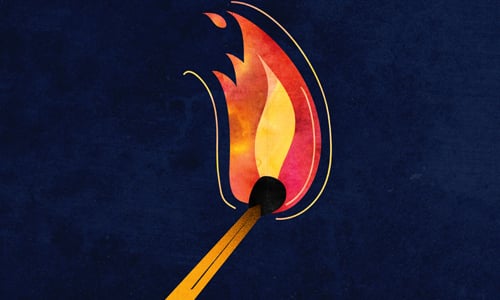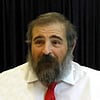Aaron the Lamplighter
The Torah portion of Behaalotecha begins with G‑d’s instruction to Aaron, the High Priest, concerning the kindling of the Menorah in the Tabernacle.
Rashi explains the segue from the previous discussion about the tribal leaders’ inaugural gifts and offerings in the Tabernacle:
When Aaron saw that each tribe presented an offering, yet his did not, he was distressed. Although the Levites were uniquely designated for holy service in the Tabernacle, Aaron was dismayed that neither he nor his tribe had any part in bringing the dedicatory offerings.
“By your life,” G‑d said to Aaron, comforting him, “your [part in the Tabernacle service] is greater than theirs, for you will light and prepare the lamps” of the Menorah!1
Aaron was told that he would create the light of the Tabernacle. What was the function of the Tabernacle’s light? It was not meant to illuminate the Tabernacle itself; rather, it was intended to bring G‑dly light into the world.2
Aaron is the custodian of the light of the world, responsible for bringing Divine, spiritual light into it. On a deeper level, Aaron brings light to the world by kindling the lamp that is the essence of every one of us.
King Solomon wrote, “Man’s soul is the lamp of the L-rd.”3 The Alter Rebbe, founder of Chabad, taught: “…The Jewish people are called ‘lamps.’ A lamp comprises a vessel, wick, oil and flame. But one must kindle the flame, and then it sheds light.”4
Every Jewish soul is a lamp, and some of those lamps must be kindled—or rekindled.
The mishnah in Ethics of the Fathers famously states that Aaron’s life mission was “loving people and drawing them close to Torah.”5 Aaron would seek out every Jew and light their lamps. He was a lamplighter.
When describing how Aaron would light the Menorah’s lamps, the verse uses the term behaalotecha, “when you raise up.” According to Rashi, Aaron had to coax the flame until it burned on its own.
We Are All Lamplighters
“Be of the disciples of Aaron,”6 the Mishnah instructs. Each of us is tasked with the mission to seek out and kindle the spark within the soul of every Jew. And we mustn’t simply kindle the lamp and walk away. We must do so in the manner of behaalotecha—coaxing the flame until it burns by itself—until it, too, becomes a lamplighter!
How do we kindle souls? What is the methodology? Not by creating our own approach or inventing our own system of outreach. We do it as disciples of Aaron: with unconditional love for every person and by drawing them close to Torah.
Aaron did not change the Torah, and he did not compromise. He did not offer people a watered-down version. He said, “I will bring you Torah. Undiluted. I will bring it one mitzvah at a time if need be, but we will not compromise.”
This, then, is our mandate: to kindle the flame of every Jew, ignite the soul of everyone we encounter, by bringing them closer to Torah.
Let us see how this theme appears again and again in our portion.
A Sight to Behold
As described in the portion of Naso, when the Jewish people traveled in the desert, they did so in a very specific formation, according to G‑d’s detailed instructions.
Try to picture the incredible scene: the Tabernacle, magnificent and majestic—gold, silver, copper, ornate tapestries—at the center. Surrounding the Tabernacle is the tribe of Levi, including the families of Moses and Aaron. Surrounding the camp of the Levites on all four sides were the camps of the twelve tribes—four camps comprising three tribes on each side. Hundreds of thousands of men, women, and children, along with their belongings, were part of this formation.
Suddenly, the Clouds of Glory, which had been resting on the Tabernacle, rise and hover above this enormous encampment—a signal that it is time to move on. Two silver trumpets, commissioned especially for this purpose, are sounded to “… summon the community and to set the divisions in motion …”7
The people hear the trumpet blasts, and the entire camp kicks into motion. The Tabernacle is disassembled, its components loaded onto the wagons and the shoulders of the Levites, and then, as one formidable mass, each tribe under its flag and banner, the nation travels onward, led by the Clouds of Glory.
Lost and Found
In the fifth section of Behaalotecha, as the Jewish people begin to journey, the Torah again spells out the detailed formation of each tribe and camp, concluding with Dan: “Then the banner of the camp of Dan set out, the collector for all the other camps, according to its legions.”8
Why is the Tribe of Dan referred to as “the collector for all the other camps?” Rashi, quoting the Jerusalem Talmud, explains, “Because the Tribe of Dan was numerous, they traveled last, and if anyone had lost anything, they would find it and return it to him.”9
In the desert, the Tribe of Dan was in charge of the “Lost and Found.”
When studying this as a young boy with my father, Rabbi Sholom B. Gordon, of blessed memory, he would refer to the Tribe of Dan as the caboose, the last car in the train. They brought up the rear, and all the other tribes relied on them to collect anything they had lost.
The Rebbe taught that in life, there is also a spiritual “Lost and Found.”
In education circles, they talk about the “kids who fall through the cracks” of the school system. There are cracks in the system of life, too, and there are people who fall through those cracks, who go off the beaten track and become lost to their brothers, lost to Judaism.
Who is going to concern themselves with these people? Who will make it their job to look after them, to show them the way back?
We cannot simply dismiss them, saying, “This is the correct path; if you follow it, that’s great, if you choose not to, you’re on your own!”
Historically, some parents would even sit Shiva—enduring a seven-day mourning period—for a child who strayed from the ways of the Torah, essentially telling these children, “You’re in the program? Good. You’re not? Sayonara! We’ll write you off.”
Along came the Tribe of Dan and said, “We are in charge of bringing back those who are lost.” If there were Jews who fell through the cracks and couldn’t keep up, the tribe of Dan gave them extra love, threw an arm around their shoulder, and said, “Come with me; you are welcome in my home—you are welcome in my heart. We are all one people.”
This is the beautiful system of outreach that the Rebbe pioneered and built. The Rebbe’s call is to each one of us: at a time when so many of our people are lost to external influences, we must all go the extra mile to help our fellow Jews find their way home.
A Second Chance
Chapter nine begins with G‑d’s instruction for the Jewish people to bring the Passover sacrifice in the desert. As it turned out, this was the only time in all 40 years of wandering in the desert that they brought this sacrifice; they went the next 39 years without bringing what was meant to be an annual offering.10 Still, in that first year, all the Jews did, indeed, bring the Passover sacrifice. Or, almost all the Jews did.
The verse states: “There were men who were ritually unclean [because of contact with] a dead person, and therefore could not make the Passover sacrifice on that day. So they approached Moses and Aaron … [and] said … “We are ritually unclean [because of contact] with a dead person; [but] why should we be excluded so as not to bring the offering of the L-rd … with all the children of Israel?”11
Why were these men ritually impure? According to many commentators, it was because they carried Joseph’s coffin during the Exodus from Egypt. Joseph had the people promise to take his coffin out, and these were the people who kept that promise hundreds of years later.
These were righteous people who did a good deed and seemed to be losing out as a result. “Why should we be excluded?” they cried, pleading with Moses to figure out a way that they, too, could partake in the mitzvah of the Passover sacrifice.
Moses was stumped. So he approached G‑d with their plea. The result? The mitzvah of Pesach Sheni, the “Second Passover.” G‑d instructed Moses: “Speak to the children of Israel saying, Any person who becomes unclean from [contact with] the dead, or is on a distant journey… he shall make a Passover sacrifice for the L-rd.”
Each year, exactly one month after Passover, anyone who was unable to bring the sacrifice in its proper time would be given a second chance.
In the teachings of Chassidism, we find profound symbolism here. Every Jew that is “far away” or “ritually impure”—all those innocent souls who, tragically, have fallen through the cracks and drifted away from Torah and Judaism—cry out from their very essence: “Why should I be excluded? I want a proper Jewish education too. I want to study Torah. Should I lose out because I live too far from a Torah center? Should I lose out because my parents didn’t know any better? Should I be excluded because I was born into a family that was far from traditional Jewish practice? I am as Jewish as every other Jew!”
The Rebbe, quoting his father-in-law, the Sixth Rebbe, Rabbi Yosef Yitzchak Shneersohn, writes: “The theme of Pesach Sheni is that it is never too late. It is always possible to put things right. Even if one is ritually impure, or far away, and even in a case when this (impurity, etc.) was deliberate—nonetheless he can correct it.”12
It’s never too late to return to and re-embrace Judaism.
It’s Up to Us
Who should provide this second chance? Who should reach out to those who are spiritually distant, and lovingly guide them back home? Every single one of us must step up and shoulder this responsibility!
In 1940, in the midst of the Holocaust, the Sixth Rebbe miraculously arrived on the shores of the United States and established the modern-day Tribe of Dan.
On a very personal note, both of my parents, of blessed memory, were at the pier in New York Harbor when the Rebbe disembarked from the ship and proclaimed, “I came to the shores of the United States to show that America is no different!” The Rebbe asserted that Judaism could thrive in America and serve as a foundation for its revival across the globe.
My father was among the first ten students of the yeshiva that the Rebbe established that very day. He did not stay in the yeshiva for long, however, for he was among the first handful of shluchim (emissaries) sent by the Rebbe to various cities to begin the nascent work of building Jewish infrastructure and raising Jewish awareness. After my parents’ wedding, they were sent out as a team, first to Springfield, Mass., and ultimately to Newark, N.J., meriting to serve as the Rebbe’s emissaries for over five decades.
The Rebbe succeeded his father-in-law and assumed the mantle of leadership of Chabad in 1950, guiding its phenomenal growth throughout the world.
This is the tribe that I was born into six months before the passing of the Sixth Rebbe, and this is the ethos that I grew up with. So it was only natural for my wife and I, along with our 3-week-old son, to move to Encino, Calif., in 1973, to establish Chabad of the Valley. At the time, there were probably no more than about 100 Chabad institutions worldwide. Today, thank G‑d, there are 32 centers13 just in the San Fernando Valley, and over 6,500 shluchim families worldwide, operating over 3,500 institutions in over 110 countries. No Jew is too far—literally or figuratively.
Let us strive to incorporate these pivotal teachings from the parshah of Behaalotecha into our daily lives. We must all be members of the modern-day Tribe of Dan. We must all be lamplighters, kindling every Jewish soul with the light of Torah and Judaism, and coaxing their flames until their souls burn brightly on their own, until they, too, become lamplighters and ambassadors of G‑d’s light!








Join the Discussion